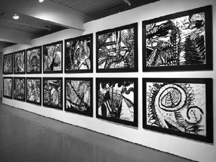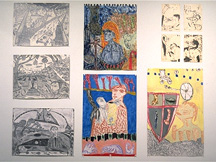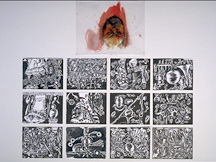- MAIN INDEX | ARTIST INDEX
| February 2 - 27, 1988 Horror Vacui Curated by Andy Fabo and Ben Walmsly | |
 Horror Vacui, Denise Malis, installation view of paintings, 1986-88. Photo Peter MacCallum. 18K | |
 Horror Vacui, Gregory Ball, 1987-88, installation detail: one of three sections, mixed-media on paper. Photo Peter MacCallum. 18K |  Horror Vacui, Kate Wilson, "Accummulation With Red", 1986-88, installation detail: one of five sections, oil and conte on vellum. Photo Peter MacCallum. 18K |
| PRESS RELEASE Horror Vacui presents works on paper and canvas by four young artists, Gregory Ball, Denise Malis, Martin Pearce and Kate Wilson, who share a similar pictorial vision of the world; a vision characterized by continual transformation, complexity, chaos and a dense saturation of elements. Their, common approach to the treatment of space is signified in the exhibition title, Horror Vacui, a term used to describe the compulsion shared by Medieval manuscript illuminators to obsessively fill every vacant part of the page with text, image or decoration. Gregory Ball's work is autobiographical, chronicling a personal confrontation with the inexplicable violence and exploitation of urban industrial life. A Vancouver artist, Ball graduated from the Emily Carr College of Art ln 1986. Since 1984, his work has been exhibited in solo and group exhibitions in Victoria, Yancouver and Toronto. The paintings of Denise Malis employ less narrative, more abstracted images to convey the power of the forces of creation and destruction. Malis received her MFA from the University of Cincinnati in l980 and her BFA from the University of Manitoba in l978. Her work has been exhibited in Toronto, Winnipes, and Tokyo, as well as Ohio, New Jersey, Indianna, and Yirginia. Like Malis, Kate Wilson explores the blurred distinctions between the recognizable image and pure abstraction. Her work reflects a concern with process, myth, regeneration, ritual, symbol and nature. Kate Wilson graduated from the Ontario College of Art in 1977 and completed further studies at the Banff School of Fine Arts and York University. Since 1979, her work has been presented in Toronto, Ottawa, Guelph and Banff, Alberta. Of the four artists, Martin Pearce is most reliant on formalism and art historical references, drawing on devices common to Cubism and Surrealism. Through these means, his work explores the physical and psychological relationships between people, animals and their environment. Pearce graduated with an MA from the Royal College of Art in London, England in 1985, and since 1979, has had exhibitions in England, (Manchester, Newcastle Upon Tyne, Canterbury, and London) and Toronto. Horror Vacui will be accompanied by an interview with coordinators Andy Fabo and Ben Walmsley, published by Mercer Union.
Horror Vacui Interview by LINDA GENEREUX, published by Mercer Union THE EXHIBITION HORROR VACUI incorporates the work of four relatively young and unknown artists: Denise Malis, Martin Pearce, and Kate Wilson who live in Toronto; and Gregory Ball from Vancouver. Each of these artists share a personal vision, characterized by a desire to crowd their picture planes with incident. Andy Fabo and Ben Walmsley have chosen to draw focus to this shared concern by titling the show with the medieval term HORROR VACUI. In the following interview, Fabo and Walmsley discuss the artist's surrender to pictorial imagery derived from the unconscious realm, and the philosophical climate around which their drawings and paintings are produced. Linda Genereux: Can you explaln the meaning of the expression Horror Vacui? Andy Fabo: Horror Vacui is a term that refers to medieval manuscripts, the urge of the monks making these illuminated manuscripts to fill up all the borders with either detailing, imagery or decorative patterning. In this show the definition is transformed to mean the urge of artists to fill the whole page when constructing a picture or drawing. It is a term that has been used extensively in art history. Ben Walmsley: Yes, simply the shunning of empty space. I think that the works of the four artists in this exhibition were chosen largely because they appear to have the same formal or stylistic characteristic, which is Horror Vacui. LG: This seems to be further translated through the artists' use of an artificially constructed perspective, similar in look to the medieval understanding or visually rendered perspective. AF: In that way I would say it really depends on the artist. Kate Wilson and Denise Malis don't even let the viewer in far enough to get a sense of space, whereas Gregory Ball constructs a space very similar to a lot of medieval art, with the plane slightly flipped toward the viewer, as Cezanne did with his tables. BW: I even think that the use of a foil or the denial of any space behind the imagery is also a very medieval characteristic. Just completely foreground. AF: In Martin Pearce's case, the works that are more formal that deal with cubism, also do that. They fill up the space so that you're not let in. In other works that I have seen where the space is pierced and moves toward naturalism, it is once again somewhat similar to medieval constructions of space. LG: So from what you have explained am I to understand that the Idea behind this exhibition centres on the concept of filling space, rather than the rendering of space? AF: Yes, I would agree with that. There's an incredible amount of incident happening here, incident as both a kind of narrative flow or interchange, and also just as mark making, happening fairly evenly across the picture plane. LG: Ben, you curated Kate Wilson Into the first Republic exhibition, THE POWER OF THE CROSS, in 1985. At that time you described the artist as "receptor or images". Do you still feel this is the case in her present work? BW: Well, I think so. Kate's practice is full of process, free association and the plundering of dream imagery. I think this indicates she works quite unconsciously or without effort of reasoning in the first generation of imagery. So, in this case, she is somewhat of a receptor as opposed to a deliberate or contrived formulator of imagery. LG: In the drawings of Gregory Ball, his subjects are almost archetypal: LANDLORD, DEATH, HOPE, WAR. Andy, In the past you described the work as "autobiographical, chronicling the artist's adventures as a sensuous waif confronting the malevolence of contemporary society". Do you think there is a true naivety at work here, or is it a more deliberate affectation of style? AF: I think with somebody like Gregory Ball that question is not all that relevant because you can't really unravel the strands. He's cognoscente, he's schooled, taken art history classes, so he's aware of more ironic art. On one hand he knows that his images are standing in the face of the general irony of Toronto art or international art right now. On the other hand, I think he is quite sincere. When he has trouble with his landlord, he does a piece about his landlord. He falls in love and does a very romantic piece about falling in love that has all the romanticism of a Chagall. I just don't think it's all that easy to say yes or no to that question. LG: Gregory Ball's work does have a primitive, almost Chagall-like quality. How do you feel his work fits into the context of what is happening on the west coast? AF: In one sense he was relatively untransformed by art school. His work was similar before. He just came out of art school knowing who his sensibility was aligned with. On the west coast, with his generation at least, I saw other young artists doing work like it but not as successfully, and not as fully conscious of what they were doing. But certainly compared to the four young Vancouver painters who called themselves FUTURA BOLD there is a strong contrast. He's not nearly as conscious or calculating about his image construction as they are. BW: I would like to think about the work of these particular artists less in terms of their peers. These four artists are each others' 'confreres' but I feel that their process, their imagery and the image generation is more mid-century. More like the early imagistic work of the abstract expressionists when they were still under the profound influence of Surrealism. LG: Then you see a Iink to some of the work being produced during the mid-century? AF: Who's work is that? BW: I was thinking particularly of Kate Wilson's work which I am quite familiar with, and Denise Malis's work, in relation to the paintings of Jackson Pollock, just in that transitional stage from imagery to abstraction, and also in the types of images he produced under Jungian analysis. LG: It is more than a loose assoclation. This becomes very apparent when looklng at the work, both in terms of his formal orderlng of space and the use of art historical references to cubism. BW: It's not just cubism with Martin (Pearce). It is a whole conflation of modern styles. Cubism in certain instsnces where he operates in an almost purely cubistic analytical manner, but in other more naturalistic paintings you see a fusion of Matisse and the cubist 'passage'... AF: There is a free kind of ambling through the early twentieth century, just grabbing a bit of this and that. LG: From what you are saying it seems that it is not only rambling, but rather these artists are choosing to reference a period that is on threshold. The cubism Pearce is using was on the threshold to another movement. It is the same threshold you were rererring to in the analogy between Kate Wilson and Pollock's evolution to drip painting. BW: It's my inclination to look at work historically because I studied art history. That's more my voice or imposition on these artists than perhaps may be relevant. I wouldn't say in any way that their work is retro, or that they're stuck in mid century formalism. AF: But I think that they are quite instinctual about choosing transitional styles. One thing that is very similar with all of them, is that none really appropriate. That is where you can't really call Kate a 'receptor or imagery'. By using the work 'receptor', it implies an involvement with semiodcs. She has another mission. I think all four are very interested in transformation. There's an active synthesis that happens after they grab this and that. The sources are transformed into something quite vital and quite new, even though their work has definite shadows from history. By choosing transitional periods from art history they allow a maximum of invention and transformation because these were periods where art was rapidly changing. LG: Denise Malis's works resist belng typecast. They oscillate between having a dark sinister quality and erupting into a blomorphic melee... BW: It's easy when you are unsettled by work to look for references to try your understanding of it. I think that is in part what we are doing here. We are trying perhaps to understand this work in terms of an art producdon we have hindsight on, and that gives us some sort of control. Whereas a large part of this work is about letting go of control for whatever pulpose to generate imagery or to delve into the unconscious; to freely associate known images, to find symbols and signs, and to understand their meanings. AF: Which means it is not a surprise that all this work comes out looking somewhat similar because it is derived from a similar theoretical base. LG: But Ben was just saying these artists develop their ideas and images quite unconsciously...? BW: It's in the same modus operandi as perhaps the previous generation. In that sense they are not being derivative. AF: They do share characteristics with the surrealists of the 40's, but because both the tenor and the collective unconscious of the times are not the same, there are market differences. LG: They are Informed by a different set of concerns now. This is evident with someone llke Gregory Ball, and Denise Malis through her repeated use or tem-le-centric subjects. AF: A feature of this work is a polarity that is created between nature and culture, culture being technology. You started to see that with Matta where his biomorphic shapes and machine-like shapes seem at war with each other. In Denise's work the line is blurred between the two. The biomorphic aspect is menacing. In Gregory's work also, technology is a menace. LG: I see it present in all or these artists' works. Gregory Ball makes rererence when writing about his work, to a distinct connection between body and landscape. Do you feel it has specific origins? BW: That is a fairly instinctively found subject - the placement of the individual in their environment. I think that these artists are quite sincere in their desire to articulate something about that search. LG: How aware do you feel these artists are or larger philosophical discusslons surrounding contemporsry art productlon? BW: There is no explicit intellectual framework around their work, and that's what makes it so exciting for us. They are not necessarily interested in structuralism or semiotics, or at least in studying these, and making work deliberately from these sorts of intellectual positions. AF: They have taken a position that is kind of proto expressionist...so I don't really connect any of their work with expressionism. On the other hand, it is well out of the main stream of language-oriented, analytical art right now. LG: I sense a strong moral tone running through the work or Pearce, Wilson and Ball... BW: When I was looking at Kate's work for THE POWER OF THE CROSS, which turned out to be, in large part, full of religious imagery, I was interested in her work because she had achieved a kind of chaotic system of imagery; signs and symbols of good and evil. She had crosses next to pentagrams, so there were Christian symbols next to Satanic and ritualistic imagery. Because they had equal prominence in the work, they achieved a balance of good and evil that I thought was quite remarkable. It was not proselytizing, it was quite human because it showed the kind of conflicts and contradictions that arise when in search of some sort of moral solution. AF: A lot of Denise's work seems beyond language, it's hard to describe. So I thitk this work is beyond ethics, although some of her works that incorporate the human figure might have a moral tone. Gregory's work definitely is... When I describe it as 'a waif's journey', it is an ethical sort of work about finding out about good and bad, and losing his innocence in the world. That is the sense you get from it, like a very expanded version of David Hockney's THE RAKE'S PROGRESS. BW: I think it might be a mistake to misinterpret their sincerity and directness for deliberate ethical expression. Because they are being honest with you, it appears that there is some sort of moralizing going on. LG: Visually there is a sense of chaos or conscious disorder In the overall image construction. Do you feel this is an attempt by the artists to create psychologlcally evocative images, or are they purely an after efrect? AF: I think you can't separate the two. Some people deal with chaos and information overload by trying to impose a false order; to become obsessed with controls so that they end up making highly controlled work. Other people traffic in chaos, they just put it all in there. There is the reflection here of the morally complete times that we live in. We are given a lot of information through the media: "this war is happening, this famine,..." I think their work deals with both media information, but also life in general these days. There are so many choices, so many possibilities, and so much has happened. Life is sped up, and there is a reflection of it in their work. LG: So you are saylng it's the truth in the work that provokes those psychologically oriented images, rather than affectatlon? BW: Definitely they are not contrived. All of these artists have a penetrating gaze. Kate, Denise and Gregory have an inward, subjective gaze which is psychologically revealing. In Martin's case it is more focussed on the physical world. His is penetrating, analyzing and seeing all sides of certain objects and in that he is creating a psychological mirror. This publication has been made possible through the generous support of the Ontario Arts Council.
| |